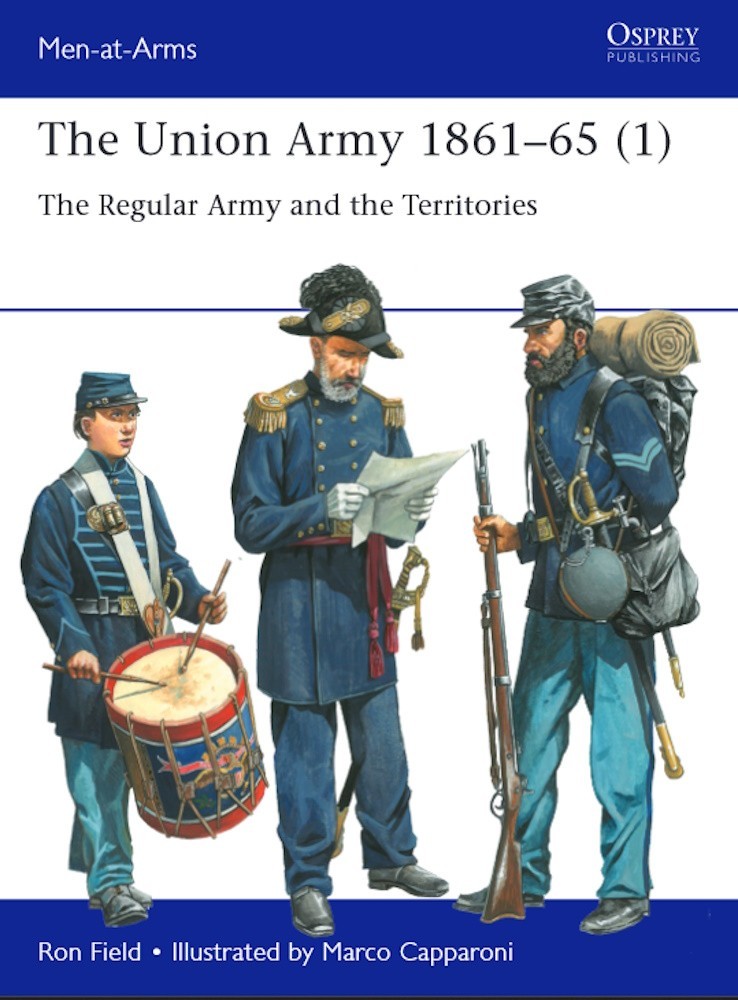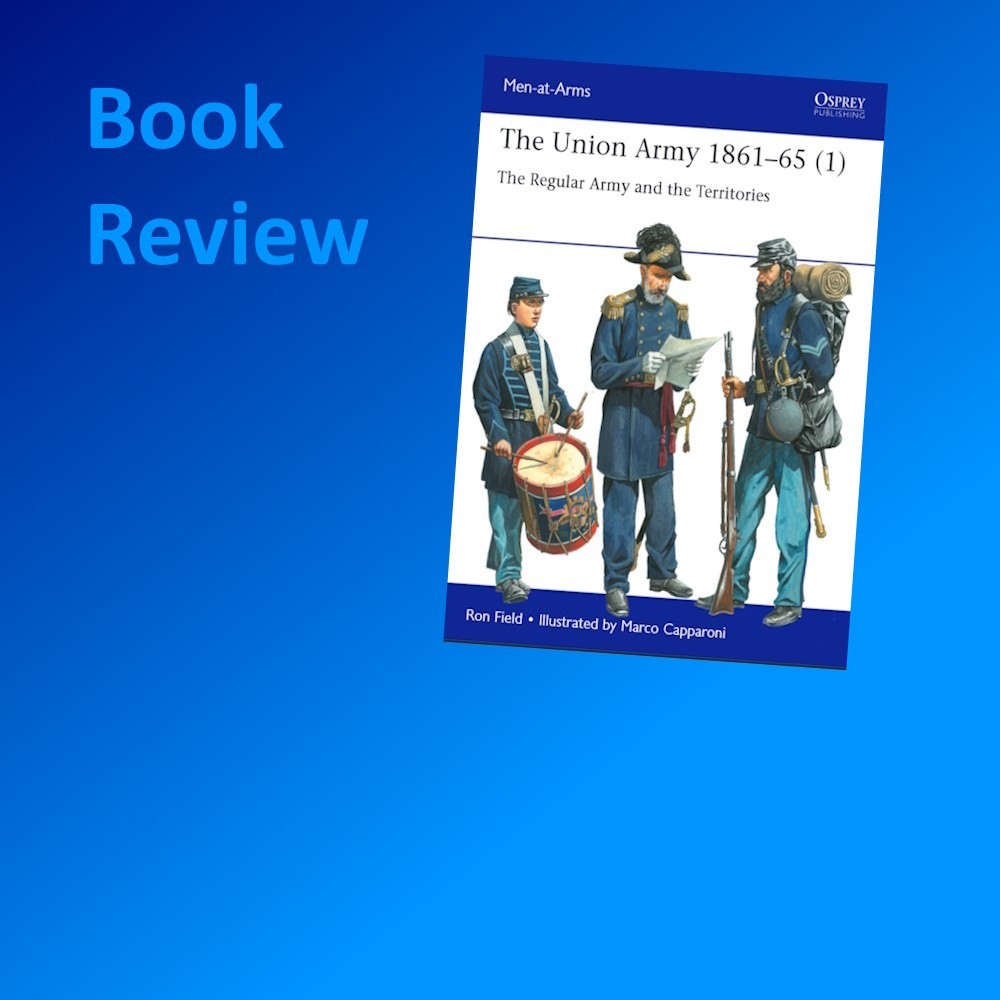
Introduction
The Union Army 1861–65 (1) The Regular Army and the Territories is a new book from Osprey Publishing. This 48-page book is the 553rd title of the series Men-at-Arms, it is catalogued with Osprey's short code MAA 553, and ISBN 9781472855770. Authored by Ron Field and illustrated by Marco Capparoni, it is available in softback, ePUB, Mobi, and PDF formats.
Osprey writes of this title;
This fully illustrated study investigates the uniforms and equipment of the US regular troops and volunteers from the territories fighting for the Union during the American Civil War.
During the American Civil War, the United States Army, pitted against the forces of the fledgling Confederacy, fought to defend and preserve the Union during five long years of bitter conflict. This volume describes and illustrates the uniforms, insignia and personal equipment of the Union Army's regular infantry, artillery, cavalry, and engineers, plus specialists such as US Sharpshooters, Veteran Reserve Corps, Medical Corps, and Signal Corps.
This volume also covers the troops fielded by the Territories that fought for the Union. Eight plates of original artwork showing officers and enlisted men of the Union Army are complemented by previously unpublished photographs of soldiers and items of uniform from some of the most comprehensive collections in the United States.
Contents
The Union Army 1861–65 (1) The Regular Army and the Territories is presented through 21 chapters and sections:
INTRODUCTION
GENERAL OFFICERS
THE GENERAL STAFF AND STAFF CORPS
INFANTRY
ARTILLERY
DRAGOONS, MOUNTED RIFLEMEN, AND CAVALRY
UNITED STATES COLORED TROOPS
UNITED STATES SHARPSHOOTERS
THE INVALID/VETERAN RESERVE CORPS
THE TERRITORIES
THE US INDIAN HOME GUARD
THE MEDICAL DEPARTMENT AND RELATED SERVICES
THE CORPS OF ENGINEERS
ORDNANCE SERGEANTS AND ENLISTED MEN
THE MILITARY TELEGRAPH SERVICE
THE SIGNAL CORPS
SELECT BIBLIOGRAPHY
PLATE COMMENTARIES
INDEX
The author explains the organization of the United States Army at the beginning of the war, including the number of troops, officers, and general officers. A contemporary "Table of Organization and Equipment" is discussed. As this survey progresses, the expansion during the war is recounted, including dates of establishments. The author presents each of the branches and units and discusses the uniforms and equipment they used. Epaulets and buttons, cuts of cuffs, coats and tails, embroidery and braids, colors and other characteristics are described. Uniforms could vary based on whether the soldier was on or off duty, and mention is made of service-issue or privately purchased garments.
When not in full dress, staff officers wore gold-bordered shoulder straps with a dark-blue ground, with eh rank of colonel indicated by a silver embroidered eagle at its center, lieutenant colonel by a silver embroidered leaf at both ends...
Specific regulations are cited, i.e., Regulations 1861:8.
Until December 16, 1861, the trousers of enlisted men serving in heavy artillery were officially prescribed as dark-blue cloth, with those for sergeants having 1 1/2in-wide scarlet seam stripes, and 1/2in wide for corporals.
Another excerpt;
Eventually on March 26, 1864, Major General George H. Thomas authorized General Orders No. 51, which permitted telegraph operators within the Department of the Cumberland to wear an undress uniform consisting of a dark-blue blouse, or sack coat; dark-blue trousers with a ⅛in.-wide silver cord along the outer seam; buff, white, or blue vest; officer-pattern forage cap without distinctive mark or ornament; and with all buttons of the “General Service” pattern.
We learn about unique uniforms for particular specialties, i.e., United States Sharpshooters (USSS) winter cover was;
...an "Austrian-gray overcoat" edged with green.
We learn of interesting anecdotes such as official resistance to the Sharpshooters receiving the rifle they wanted until President Lincoln intervened.
The text is a valuable resource for those who want to know the differences in uniforms and kit.
Photographs and Artwork
A good gallery of photos and art supports the text. Contemporary photos are black-and-white although there are several colorized photos in the book. Many color photos present artifacts in museums and collections.
Eight pages of color art present what the camera missed. These depict soldiers and buttons, buckles, etc.
Plate A, Infantry
1. Infantry colonel, 1861
1a. "Infantry I" pattern
1b. Pattern 1851 officer's belt plate
2. Company musician, 2nd Infantry, 1862
3. Corporal, 1864
Plate B, Artillery
1. Captain
2. Russian shoulder knot
3. Bugler
4. Sergeant
5. Pattern 1858 enlisted artillery insignia
Plate C, Dragoons, Mounted Riflemen, and Cavalry
1. Dragoons private
2. Mounted private
3. Cavalry First Lieutenant
4. "General Staff" button
Plate D, US Colored Troops and US Sharpshooters
1. Private, USCT
2. Infantry horn insignia
3. Pattern 1826 "Eagle" plate
4. Private, USSS
5. "General Service"-pattern rubber button
6. Sergeant, USSS
Plate E, Invalid/Veteran Reserve Corps and US Indian Home Guard
1. Private, Veteran Reserve Corps
2. Captain, Invalid Corps
3. Chasseur-pattern forage cap
4. Private, mounted Indian Home Guard
Plate F, Medical Department and Related Services
1. Hospital steward
2. Medical surgeon, Captain
3. Medical Surgeon cap insignia
4. Ambulance Corps, Private
Plate G, Corps of Engineers and Ordnance Department
1. First Lieutenant, Corps of Engineers
2. "Turreted Castle" insignia
3. "Eagle and Essayons" button
4. Private of Sappers, Miners and Pontoniers
5. Ordnance sergeant
Plate H, Military Telegraph Service and Signal Corps
1. Telegrapher, Dept. of Tennessee
2. Signal Corps Lieutenant
3. Private, Signal Corps
4. Signal Corps insignia
Several pages of plate commentaries describe each illustration in more detail, i.e.,
F: MEDICAL DEPARTMENT AND RELATED SERVICES
(1) Hospital steward, Medical Department, 1862
On hospital duty, this steward carries a medical tin pannier containing linens, bandages, dressings, and medicine bottles. His chasseur-pattern forage cap has a small, rounder version of the non-regulation medical officer’s “MS” in wreath insignia at the front. Trimmed with sky blue, his Pattern 1858 frock coat has “General Service” buttons, and is worn open to show his vest and non-regulation shirt. Ranked the same as an ordnance sergeant, he has green half-chevrons edged with yellow and bearing a caduceus device, the traditional symbol of the Greek god Hermes composed of two snakes winding around a winged staff. Commensurate with his rank, his trousers have 1½in.-wide dark-blue welts in the outer seams.
Conclusion
American Civil War figures have been popular with modelers for over a century. New models such as ICM's 1/35 Union Infantry American Civil War and many 54mm metal figures prove this. The Union Army 1861–65 (1) The Regular Army and the Territories is a good primer for modelers and enthusiasts of the Union Army. The author presents a good description of the uniforms with historical data. The text is supported with a useful gallery of photos and artwork. Commentaries provide even more detail.
I think this a good resource for modelers of the subjkect and recommend this book.
Please remember to mention to Osprey and retailers that you saw this product here - on Armorama.

